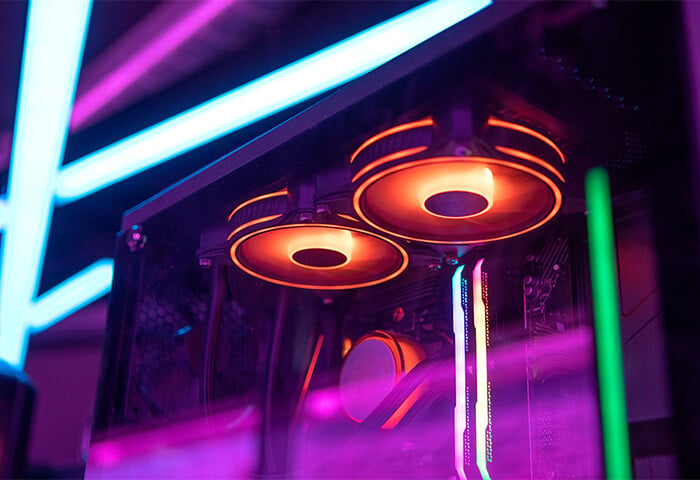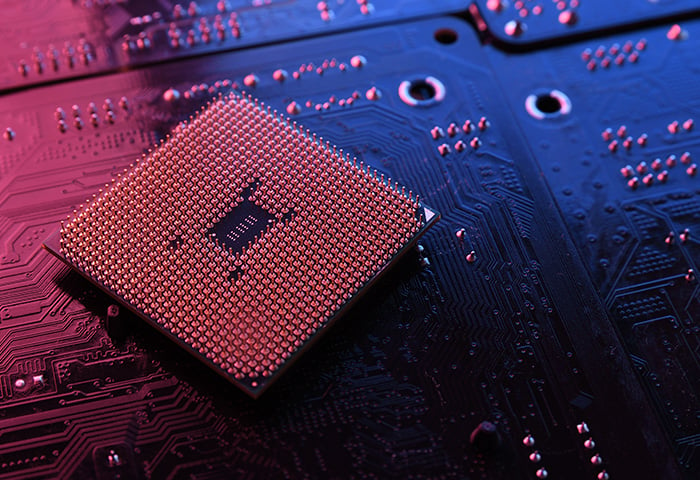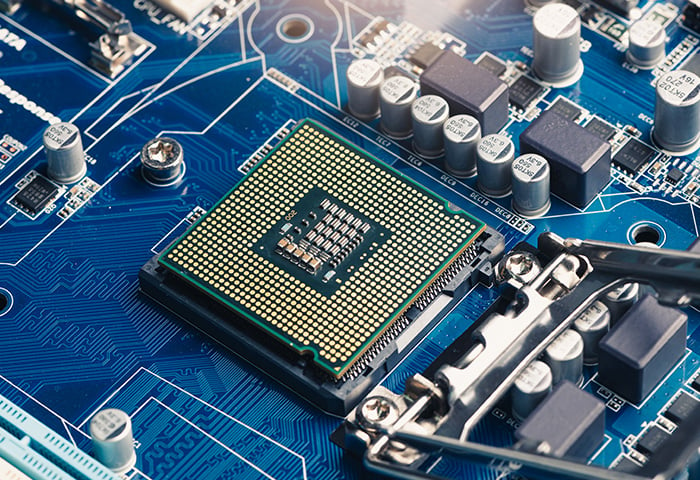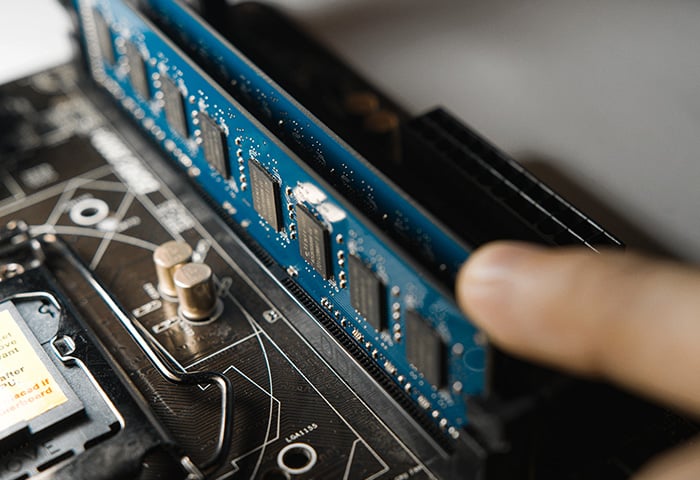AMD vs. Nvidia GPUs: What’s the difference?
AMD is often considered the budget-friendly (and user-friendly) GPU choice, delivering excellent value in mid-range graphics cards and competitive performance for gaming. Nvidia, on the other hand, dominates the high-end market, with superior ray tracing, AI-powered features like DLSS, and a robust software ecosystem for tasks like video editing and 3D rendering.
When choosing between AMD and Nvidia, remember that different GPUs cater to different needs and budgets, so consider your specific requirements and expectations to help make a smarter purchase. Before clicking “buy now,” brush up on the difference between a GPU and a CPU, learn how to test your computer’s performance, and determine if your computer is powerful enough to support your gaming needs.
AMD GPUs
Founded in 1969, AMD began as a semiconductor company specializing in memory chips and other computer components. In 2006, they acquired ATI Technologies, a leading Canadian 3D graphics card manufacturer. This propelled AMD into the GPU market, where they’ve done well in the console world, particularly with PlayStation and Xbox.
The AMD GPU with the highest performance is currently the AMD Radeon RX 7900 XTX, while the most popular AMD GPU is the AMD Radeon RX 6600, according to the latest Steam Hardware and Software survey.
AMD's current range of GPUs is the Radeon RX 9000 series, which started launching in March 2025 and will continue throughout the year, followed by the specs for the full AMD Radeon RX 7000 series.
Here are the high-level stats for the latest AMD GPUs:
| Model |
Target resolution |
Max memory (VRAM) |
Release date |
Price* |
| Radeon RX 9070 XT |
4K |
16 GB |
March 2025 |
From $599 |
| Radeon RX 9070 |
4K |
16 GB |
March 2025 |
From $549 |
| Radeon RX 7900 XTX |
4K |
24 GB |
December 2022 |
From $999 |
| Radeon RX 7900 XT |
4K |
20 GB |
December 2022 |
From $734 |
| Radeon RX 7800 XT |
1440p |
16 GB |
September 2023 |
From $589 |
| Radeon RX 7700 XT |
1440p |
12 GB |
September 2023 |
From $529 |
| Radeon RX 7600 XT |
1080p |
16 GB |
January 2024 |
From $399 |
| Radeon RX 7600 |
1080p |
8 GB |
May 2023 |
From $289 |
* All prices are subject to change. They were taken from newegg.com and reflect the lowest price available as of April 2025.
No matter which AMD GPU you use, keeping your graphics drivers up to date is essential for maximizing gaming performance and ensuring compatibility with the latest titles and features.
Nvidia GPUs
Nvidia was founded in 1993 with computer graphics in mind from the beginning. Now worth over $3 trillion dollars, it’s one of the world's most valuable companies. But despite its beginnings as a gaming GPU manufacturer, Nvidia is currently a global leader in AI and data center computing — nearly 90% of the company’s revenue came from these segments in 2024.
The Nvidia GPU with the highest performance is the newly announced Nvidia GeForce RTX 5090, which features the proprietary Blackwell architecture that makes the GPU so well suited to high-end gaming and AI computing.
The newest GPUs released by Nvidia are the 50 series. All have a target resolution of 4K — here are their other stats:
| Model |
Max memory (VRAM) |
Release date |
Price* |
| GeForce RTX 5090 |
32 GB |
January 2025 |
From $1999 |
| GeForce RTX 5080 |
16 GB |
January 2025 |
From $999 |
| GeForce RTX 5070 Ti |
16 GB |
February 2025 |
From $749 |
| GeForce RTX 5070 |
12 GB |
March 2025 |
From $549 |
* All prices are subject to change. They were taken from nvidia.com in April.
Driver updates for Nvidia cards are also released regularly, and it’s important to stay up to date to ensure you’re getting the best performance from your GPU.
AMD vs. Nvidia: Gaming
AMD Radeon graphics cards are great for gaming, especially when your main priority is getting a good price-to-performance ratio. If budget is less of a concern for you, Nvidia equivalent cards include more advanced technology — DLSS (deep learning super sampling), ray tracing, and AI capabilities — that can ultimately provide better performance overall, but for a heftier price tag.
When comparing AMD and Nvidia GPUs for gaming, the main differences come down to performance features and pricing. For example, while AMD often provides more straightforward overclocking, Nvidia frequently pushes out driver updates aligned with major game launches, helping to optimize performance right out of the gate. While both brands excel in different areas, AMD is often the more budget-friendly choice for comparable performance.
Ray tracing
Ray tracing is a visual rendering technique that mimics how light works in the real world. By tracking the path of light as it interacts with objects, ray tracing creates ultra-realistic visuals in video games. Think crisp reflections on shiny surfaces, light bending through glass or water, realistic shadows that change in sharpness, and soft, natural lighting spreading across a scene.
Both AMD and Nvidia offer some ray tracing capabilities in their GPUs, though the technology differs. Nvidia uses proprietary RTX cores in their newer cards, while AMD uses a software-based approach with their Radeon Ray accelerators.
The AMD Ray accelerators improve the ray tracing performance in AMD GPUs (and at a more affordable price), but they’re still not comparable to Nvidia’s ray tracing technology. That being said, ray tracing is still relatively new, and not all games even support it yet.
Adaptive sync
Adaptive sync is a technology that synchronizes a GPU's frame rate output with your monitor’s refresh rate, which provides a more seamless visual experience. It helps reduce stuttering, lag, and screen tearing while gaming.
Both Nvidia and AMD use adaptive sync technology. AMD offers Freesync, which is generally compatible with more monitors, due to not requiring any proprietary modules. Nvidia has proprietary G-Sync, which offers better performance and consistency, but at a higher cost.
AMD vs Nvidia: Comparison chart
For many people, upgrading a gaming PC is the main reason to invest in better graphics cards, and they often come with a hefty price tag. If other gaming system components aren’t up to snuff — such as an older monitor that lacks high refresh rates, or an overworked CPU — they could bottleneck the performance gains you'd otherwise get from a more advanced GPU.
Similarly, FPS (frames per second) and maximum power draw heavily depend on other components of your system, like your monitor and power supply.
With that in mind, let’s look at a few competing graphics cards in this AMD vs Nvidia comparison chart, so you can see which GPU is best for boosting your game performance. In this section, we’ve selected a few AMD and Nvidia equivalent GPUs to get a closer comparison:
| GPU Model |
Target resolution |
VRAM |
Ray Tracing Performance |
Power Draw (TBP) |
Dimensions (L x W x H) |
AMD Radeon
RX 7600 |
1080p |
8 GB |
Moderate |
165W |
229mm x 111mm x 50mm |
AMD Radeon
RX 7600 XT |
1080p |
16 GB |
Moderate |
190W |
229mm x 111mm x 50mm |
AMD Radeon
RX 7700 XT |
1440p |
12 GB |
Good |
245W |
304mm x 131mm x 56mm |
AMD Radeon
RX 7800 XT |
1440p/Entry-level 4K |
16 GB |
Good |
263W |
279.9mm x 133.9mm x 49.3mm |
AMD Radeon
RX 9070 XT |
Entry-level 4K |
16 GB |
Improved |
355W |
331mm x ~129mm x 66mm |
Nvidia GeForce
RTX 4060 |
1080p |
8 GB |
Excellent |
115W |
227.2mm x 123.24mm x 49.6mm |
Nvidia GeForce
RTX 4070 Super |
1440p/Entry-level 4K |
16 GB |
Excellent |
216W |
244mm x 120mm x 40mm |
Nvidia GeForce
RTX 5090 |
High-end 4K/8K |
32 GB |
Exceptional |
450W |
304mm x 137mm x 61mm |
There are other effective ways to maximize your gaming performance without relying solely on pricey hardware. Here are some guides on getting the most out of popular games, such as:
AMD vs. Nvidia: Laptop
When it comes to laptops, Nvidia edges out AMD almost by default, as most gaming laptops come with an Nvidia GPU. However, some select models come with a GPU from the AMD Radeon 7000 series.
While it’s possible to build your own laptop, it’s far less common than assembling a desktop PC. That’s why built-in capabilities like video editing performance, rendering speeds, and 3D modeling efficiency are crucial factors when evaluating a laptop GPU.
These are some of the most common laptop GPUs:
-
Nvidia GeForce RTX 4060 Laptop GPU
-
Nvidia GeForce RTX 3060 Laptop GPU
-
AMD Radeon RX 7600S
-
AMD Radeon RX 6550M
-
Nvidia GeForce RTX 4050 Laptop GPU
When it comes to MacBooks, both AMD and Nvidia GPUs were used in the past, but Apple has since transitioned to using its own in-house GPUs in newer models. Just like with other laptops, knowing how to speed up your MacBook when it slows down — and how to maintain peak performance over time — is essential.
Laptop GPU equivalents table
Choosing the right laptop and graphics card can feel overwhelming with so many models out there. To help make it easier, we’ve put together a detailed comparison list of AMD and Nvidia equivalent GPUs to help you find the best fit for your needs and budget.
Below is a comparison table of Nvidia and AMD equivalent GPUs:
| Nvidia Laptop GPU |
AMD Laptop GPU |
| GeForce RTX 5080 |
N/A |
| GeForce RTX 5070/5070 Ti |
N/A |
| GeForce RTX 4080 |
Radeon RX 7900M |
| GeForce RTX 4060 |
Radeon RX 7600M XT |
| GeForce RTX 4050 |
Radeon RX 7600S |
| GeForce RTX 3080 |
Radeon RX 6850M XT |
| GeForce RTX 3060 |
Radeon RX 6600M |
AMD vs. Nvidia: Cost comparison
Checking GPU prices one by one can be tedious, so we’ve put together a list of some AMD and Nvidia GPUs sorted into budget, mid-range, and premium tiers. This should give you a better idea of what to expect price-wise.*
| GPU Model |
Category |
Price |
Nvidia GeForce
RTX 5090 |
Top-of-the-line |
$1999 |
AMD Radeon
RX 9070 XT |
Top-of-the-line |
$599 |
Nvidia GeForce
RTX 4090 |
High-end |
$1599 |
Nvidia GeForce
RTX 5080 |
High-end |
$999 |
Nvidia GeForce
RTX 4080 |
High-end |
$999 |
Nvidia GeForce
RTX 3080 |
High-end |
$569 |
AMD Radeon
RX 9070 |
High-end |
$549 |
AMD Radeon
RX 7900 XTX |
High-end |
$999 |
AMD Radeon
RX 7900 XT |
High-end |
$734 |
AMD Radeon
RX 6800 XT |
High-end |
$519 |
Nvidia GeForce
RTX 4070 |
Mid-range |
$579 |
Nvidia GeForce
RTX 3070 |
Mid-range |
$429 |
AMD Radeon
RX 7800 XT |
Mid-range |
$589 |
AMD Radeon
RX 7700 XT |
Mid-range |
$529 |
AMD Radeon
RX 6700 XT |
Mid-range |
$329 |
Nvidia GeForce
RTX 3060 |
Budget |
$299 |
AMD Radeon
RX 7600 XT |
Budget |
$399 |
AMD Radeon
RX 7600 |
Budget |
$289 |
AMD Radeon
RX 6600 XT |
Budget |
$239 |
* All prices are subject to change. They’re based on nvidia.com and newegg.com listings and reflect the lowest price available as of April 2025.
AMD vs. Nvidia: Which is better overall?
When you choose between an AMD GPU or an Nvidia GPU, you’re probably considering the price-to-performance ratio. If budget and value are your priorities, AMD graphics cards generally give you the most bang for your buck. If high-performance gaming and visual rendering are your number one priorities, regardless of budget, Nvidia is the clear winner.
Determining which GPU is better for you when it comes to AMD or Nvidia will come down to finding the right balance of features, performance, and cost, based on your specific needs.
AMD vs. Nvidia: Advantages and disadvantages
Here are some general pros and cons of both AMD and Nvidia GPUs:
AMD GPU Pros
- Generally lower cost
- Often a higher VRAM than equivalent cards
AMD GPU Cons
- Usually higher power consumption
- May run at higher temperatures in general
- Poorer ray tracing than Nvidia
As this comparison table shows, AMD GPUs offer excellent value for money, especially in mid-range and budget segments. They’re known for excellent value, solid multitasking, and competitive performance in modern games. But, if you’re not so budget-conscious, higher-end Nvidia hardware will likely yield higher overall performance:
Nvidia GPU Pros
- Ray Tracing and DLSS are highly optimized
- Generally run cooler than AMD equivalents
- Frequent driver updates coinciding with major game releases
- Better app support for non-gaming tasks, such as AI computing and video editing
Nvidia GPU Cons
- Significantly higher cost
Get the most from your PC with AVG
A GPU upgrade can be a great way to improve your PC’s performance, but there are easier and cheaper ways to soup up your system than buying a new graphics card.
Install AVG TuneUp to speed up your computer by removing junk files to free up extra space, updating your programs automatically, and uninstalling software you no longer need. Take the hassle out of unleashing your computer’s full potential with AVG TuneUp today.















